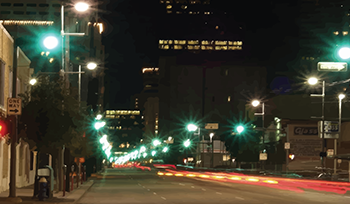InTrans / Jul 29, 2015
City by City: Urban living
Go! Magazine

posted on July 29, 2015
In our last article, “Town by Town: Suburban Living,” we looked at how suburbs are being re-imagined to include more than just car-oriented transportation. In this article, we will be taking a look at how people get around in one of the densest cities in the United States—Los Angeles.
As the second largest city, Los Angeles, California, boasts a population of almost four million people. With such a dense population, Los Angeles has tried to come up with ways to improve the flow of traffic throughout the city.
Did you know that in 2014, the average Los Angeles driver spent almost 60 hours in traffic and wasted nearly 27 gallons of fuel? That means that the 1.2 million of the 1.4 million1 workers in Los Angeles that commuted to work by personal vehicle in 2000 wasted 32.4 million gallons of gasoline (or over $100 million dollars according to 2015 gas prices) sitting in traffic.
With people, transportation, and traffic come air pollution, and with the Los Angeles climate only allowing for about 35 days of precipitation annually, this amount of pollution makes this city one of the worst in the country. Remember, rain helps “wash away” pollution! So without the help of Mother Nature in addition to the large amount of people living in or near the city, Los Angeles has a huge air pollution problem. The solution? Lessening traffic. How? Through implementation of the nation’s most extensive traffic mitigation project ever.
Keeping traffic moving
Being late. Frustrating. Halted at a traffic light. Doubly frustrating. Well, Los Angeles is trying to reduce the amount of time drivers spend idling at stop lights to help reduce air pollution.

To reduce wait times at traffic lights, city officials spent more than $400 million dollars to synchronize traffic lights throughout Los Angeles. The project included all 44,000 traffic signals and covered nearly 470 square miles (i.e. an area of about 22 miles wide and 22 miles long). The impetus for this project was the 1984 Olympics—city officials knew that they couldn’t widen the streets, so instead decided to try synchronizing just a few traffic lights in an attempt to increase the flow of traffic. It was so successful that they expanded it to the whole city in 2013!
But how does it work?
How do you synchronize traffic lights during heavy verses slow traffic? Well, Los Angeles implemented a high-tech monitoring system, which included 450 cameras, 4,400 computerized traffic light signals, 25,000 magnetic, underground sensors, and an underground fiber-optic cable to link it all together. That is a lot of data! So who manages it?
Behind the scenes, there is a group of people working in the Los Angeles Department of Transportation’s Automated Traffic Surveillance and Control (ATSAC) System. These people, made up of 22 traffic engineers, help keep traffic flowing by keeping an eye on (i.e. monitoring) the streets nearly every day of the week. But what exactly do they do to help?
Well, first let’s say there are 50 vehicles on the street. All of these vehicles would pass through and signal the magnetic, underground sensors, which would check speed, count the number of vehicles, and adjust traffic lights accordingly (i.e. turn the traffic light green at the right time). But what if there was a crash? That’s where members of the ATSAC System team come in. They are able to respond immediately and alert the right officials.
The ATSAC System team also assists the flow of traffic automatically when cars are lined up and sitting on the detectors, which makes the signal length time change automatically based on the number of cars waiting at any given intersection. Since traffic light lengths may be different based on the time of day, and when there is an unexpected number of cars on a given street, the ATSAC System team can override the traffic signals temporarily thus allowing the green light to remain active longer and relieve that unforeseen traffic backup.
An added benefit to the ATSAC System and their operation center hub is that Los Angeles commuters can access the same real-time traffic information for any area of the city from their website. This website, which is updated approximately every 30 seconds, shows what streets currently have heavy traffic so drivers can plan their routes accordingly.
This effort has been extremely successful in helping to move traffic in Los Angeles. In fact, since the system’s start in 2013, speeds have increased by 16 percent and travel times reduced by 12 percent.2 This traffic management system is indeed a success and has accomplished its fundamental goal of receiving and reacting to minute-by-minute traffic information to make decisions about signals to, in turn, reduce traffic times and air pollution.
Citations
Related links
http://trafficinfo.lacity.org/
http://www.cbsnews.com/news/los-angeles-engineers-new-traffic-system-to-help-congestion/
http://la.curbed.com/archives/2014/10/la_is_the_third_best_us_city_for_public_transit_commuting.php
By Jackie Nester, Go! Staff Writer